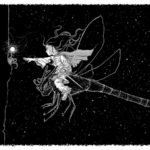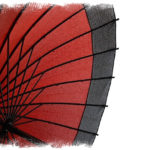Sita – when you followed
your blue-skinned lover
along tangled forest paths
Did he marvel at your fearless laughter
filling the darkness with hope?
Did his heart lift at the sight of you,
his sure-footed wife
marching melodically into the wilderness
on bell-garlanded feet?
Did he realise that this was your place?
the biting green of vine and leaf
the howl of creatures still unknown
the damp earth beneath your feet
the sweet familiar breath of home.
Sita – did you dance into a hoop of flames
holding your painted hands before your face?
Did he weep as the fire wrapped you
in its silken embrace?
And you cried out for the shade of a fig tree
and the fragrance of rain-beaten earth…
Did he watch as you stepped out of ashes
shaking embers from your hair?
Did he hear you call upon your mother
to open her arms and clasp you to her heart?
Did he witness your leap into the abyss?
Sita – pure as the morning – born in a furrow
Falling, unafraid, into black endlessness…
……………………………………………………
Sita, the wife of Rama, is the principal female character in the Ramayana, an Indian epic which underpins Hinduism, and is the oldest written story in the world.
When Rama is banished to the forest for fourteen years instead of being crowned king, Sita goes with him. They live happily in the forest until Sita is captured by a demon king named Ravana. Rama and his brother Laksmana eventually rescue Sita, with the help of an army of monkeys, but Rama doubts Sita’s purity. Sita endures a trial by fire sati and comes out unscathed.
At the end of the epic, Sita once again proves her purity and, instead of returning to Rama, she begs her mother earth to take her back. The earth opens, she throws herself into the chasm and the earth closes over her.
Sita is a fertility goddess, intimately connected with nature and shakti (a feminine energy force). Although thought to be a perfect embodiment of womanhood, Sita is not as submissive as we might suspect. She gives a spirited speech which includes a passionate rebuke of Rama’s cruelty, and a lucid explanation of where moral responsibility lies in the case of violence against women.
In the final chapter of the Ramayana, she chooses her own fate, instead of remaining with a man who has twice abandoned her.
I wrote the poem Sita as a response to the Ramayana because I have always been fascinated by Sita’s place (as a woman) in this Hindu epic.
My poem offers Sita’s perspective in a story that has traditionally been completely centred around the male protagonist, Rama.



